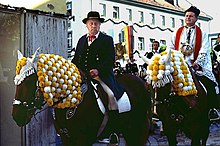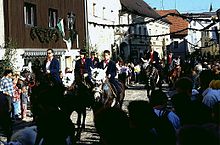Kötztinger Pentecost
The Pentecost of Kötzting is one of the largest mounted processions in Europe and goes back to a promise made in 1412 . Since this year, every year on Whit Monday, over 900 riders have been praying on decorated horses and in traditional costumes from the Bavarian Forest from Bad Kötzting through the Zellertal to Steinbühl.
history
Since the congregation of Steinbühl was incorporated into the parish of Kötzting at the beginning of the 15th century, the pastor had to walk the seven-kilometer route to Steinbühl for church services and other occasions. But he found himself unable to get there without protection. Therefore, at his request, the Kötztinger boys escorted him. After a happy return, they vowed to repeat the ride every year.
There are two legends about the reason for the first ride. After the first, a man was dying in Steinbühl and asked for the sacraments of death . After the second, the escort was supposed to protect the pastor from the dangers of riding through the dense forest populated with wild animals.
The Pentecost
Under the ringing of church bells, citizens and farmers leave the city on decorated horses praying , renewing the age-old vow. Traditionally, only men are allowed to take part in the ride. The equestrian procession is led by the cross bearer. He is followed by lantern-bearers, fanfare-blowers , clerical officer with sacristan and acolytes . Behind them the Pentecostal groom rides with the two brides .
The official tip is completed by the Pentecostal groom of the previous year, who carries the market flag, with his bridal guides and the fraternity representative . The remaining riders join. Many of them carry flags of remembrance that they have received for many years of riding. The riders pray the rosary on the way . The officer preaches the gospel at four stations .
In the Pentecostal pilgrimage church of St. Nikolaus in Steinbühl there is an equestrian service. After a break for horse and rider, the equestrian procession moves back to Bad Kötzting at 12 noon . The ecclesiastical part of the Kötztinger Pentecost ends with the Te Deum (Praise to God).
The virtuous wreath
The virtue wreath, popularly known as the “Pfingstkranzl”, is a filigree made of gold and silver wire. Designed by local women in the 19th century, it was later made in Mallersdorf Abbey . The Tugendkränzchen has been coming from the Seligenthal Landshut Monastery since 2007 . The clergyman wears it on his pectoral cross during the ride and also gives the blessing in the four Gospels and at the end of the Whitsun Mass .
The name Tugendkränzchen is derived from the earlier tradition of handing it over to the young man on arrival in Steinbühl, who had distinguished himself with exemplary behavior the year before. That is why the “Pfingstkranzl” is still the greatest pride of a Kötztinger town hall today.
At the end of Pentecost, the virtue wreath is ceremoniously presented to the Pentecostal bridegroom on the town square. Whit groom unmarried , Catholic and in the district of Bad Kötzting be resident has to be, at the proposal of the City Council from the town priest appointed.
The Pentecost wedding
After his appointment, the Pentecostal bridegroom chooses a Pentecostal bride and two bridesmaids. After Pentecost, he hosts the fraternity in his parents' house. At around 4 p.m., the Pentecostal bride is picked up for the boys' and bridal procession.
Together with the boys, the Whitsun bride and groom then go through the festively decorated city to the guest's house, where the Whitsun wedding is celebrated. The Pentecost wedding is only symbolic . The Pentecostal bride and groom, like the Pentecostal bridegroom, must be single, Catholic and reside in the Bad Kötzting district .
Pentecost 2004
In 2004 a bishop rode to Steinbühl and back with the Whitsun riders for the first time . Gerhard Ludwig Müller , Bishop of Regensburg , has upgraded the religious dimension of this tradition and with a decree made the Kötztinger Pentecost into a Eucharistic procession . In 2004, for the first time in 135 years, the Holy of Holies was allowed to be carried again after this was banned by a pastoral decree of Bishop Ignatius of Senestrey on January 17, 1869. Gerhard Ludwig Müller has participated almost every year since then, even after his appointment as cardinal in 2014.
literature
The Pentecost is described in Maximilian Schmidt's novella Die Pfingstelbraut .
Awards
- 2005: Culture Prize of the Upper Palatinate District in the Customs category
Web links
- The Pentecost in Bad Kötzting
- Pentecost in the 19th century
- Pentecost 2015 with Cardinal Gerhard Ludwig Müller
Individual evidence
- ^ Pfingstritt zu Bad Kötzting , website of the city of Bad Kötzting



